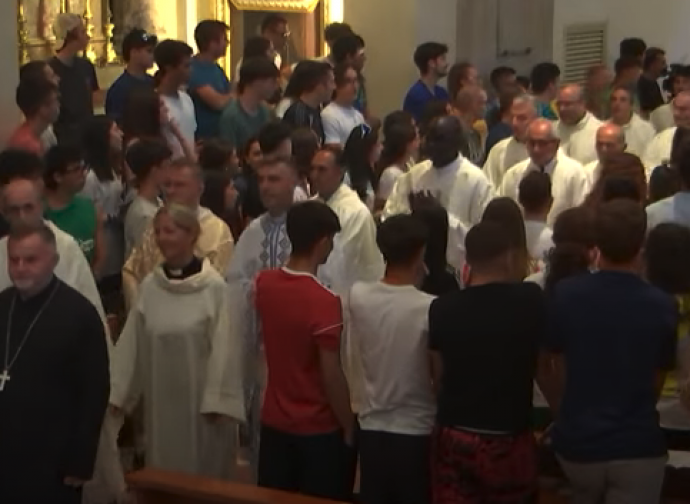A 'Priestess' in the Holy House of Loreto: Ecumenism of Confusion
After Brazil, the Basilica of Loreto where the Holy House of Mary is enshrined is cause for scandal: among the concelebrants, a woman vested in a cassock and collar (Protestant?). In the name of forced 'communion', the same misunderstanding is repeated and trumpeted, regardless of whether it pleases God.

Basilica of the Holy House of Loreto, 28 July 2025: the bishops of the Marche region in Italy concelebrate Holy Mass to mark the Jubilee of the young people of their region. During the entrance procession, behind the deacon solemnly carrying the Gospel Book and following three priests without liturgical vestments, there are representatives of Eastern churches, probably non-Catholic, alongside a Catholic priest, a woman wearing a cassock from which the ecclesiastical collar is visible, (watch here at minute 5:50). She is likely a Lutheran pastor, whose name we do not know.
She then took her place in the presbytery (minute 10:45), again alongside a priest, where she remained throughout the Eucharistic celebration presided over by the Archbishop of Pesaro-Urbino-Urbania-Sant'Angelo in Vado, Monsignor Sandro Salvucci. A worshipper present testified that during the consecration, the 'minister' extended her hand as a sign of concelebration. Unfortunately, the video of the celebration does not allow us to confirm this; however, when the bishop resumed the Eucharistic Prayer immediately after the acclamation of the faithful, she can be seen extending her hand again at 50:02, which makes it highly probable that she made the same gesture during the words of consecration.
Therefore, it seems that all the elements are present to suggest that the woman, evidently belonging to a Christian community that 'does not have apostolic succession and does not recognise the sacramental dignity of priestly ordination' (CIC, can. 908), attempted to disrupt the concelebration in the Holy House, in front of bishops and priests from the Marche region. This is one of the delicta graviora reserved for the judgement of the Congregation for the Doctrine of the Faith (cf. Normæ de delictis Congregationi pro Doctrina Fidei reservatis, art. 3 § 1).
In February of this year, we reported a very similar incident during the pontifical Mass for the installation of Monsignor Odelir José Magri in the Diocese of Chapecó (Santa Catarina, Brazil). On that occasion, an Anglican 'presbyter' entered in procession with the Catholic priests, dressed in a priest's alb and stole, and the woman took her place in the presbytery, even receiving Communion at the altar. In Loreto, it seems that the same thing happened, except for Communion.
It also seems that bishops care little about delicta graviora against the Eucharist sacrament, as well as the confusion that certain 'ecumenical gestures' can cause among God's people. Yet concelebration with ministers of non-Catholic communities remains prohibited, especially with Christian denominations that do not have the sacramental priesthood.
It could be argued that the bishops did not anticipate the 'minister' extending her hand in a sign of concelebration. While this argument is valid, it raises the question of why she was permitted to enter in procession wearing a white alb alongside the Catholic priests and stand in the presbytery with them. In such situations, the presence of non-Catholic ministers at the celebration of the Eucharist must be managed so as to avoid any confusion and to prevent an undue 'push forward' towards communicatio in sacris, which remains prohibited due to the absence of full effective communion.
Holy Mass is not the place to promote ecumenism and hospitality; these goals can be achieved elsewhere. As Benedict XVI explained in his post-synodal apostolic exhortation Sacramentum Caritatis on 22 February 2007, 'the respect we owe to the sacrament of the Body and Blood of Christ prevents us from making it a mere "means" to be used indiscriminately to achieve this same unity'. The crucial point is that 'the Eucharist not only manifests our personal communion with Jesus Christ, but also implies full communion with the Church'. This is why, with sorrow but not without hope, we ask non-Catholic Christians to understand and respect our conviction, which is based on the Bible and Tradition'.
As the sacramental and mystical body of Christ is one, 'Eucharistic communion and ecclesial communion are so intimately connected that they generally make it impossible for non-Catholic Christians to have one without enjoying the other' (n. 56). For this reason, the Pope stated that 'true concelebration with ministers of churches or ecclesial communities not in full communion with the Catholic Church is meaningless'.
Canon 844 sets out the circumstances in which a Catholic may receive the sacraments of penance, Eucharist and anointing of the sick from a non-Catholic minister who is validly ordained. It also covers cases in which a Catholic minister administers these sacraments to non-Catholic faithful, in accordance with the principle of salus animarum.
However, any form of Eucharistic concelebration is expressly prohibited (cf. can. 908). Therefore, if there are reasons of convenience for non-Catholic ministers to be present at the Eucharistic celebration, their participation must not cause confusion. They may be given a place of honour, but it is entirely inappropriate for these ministers, especially those without valid priesthood, to walk in the initial procession with Catholic priests, be present in the presbytery, or wear liturgical vestments.
In fact, the entire celebration needs to be reviewed, from the continuous verbose interventions and applause to the guitars and percussion and the priests with rather pronounced egos who look around, smile and chat. It's a disaster across the board. The 'communion' between Protestants and Catholics is becoming ever closer. But in the opposite way of what the Lord wanted.




